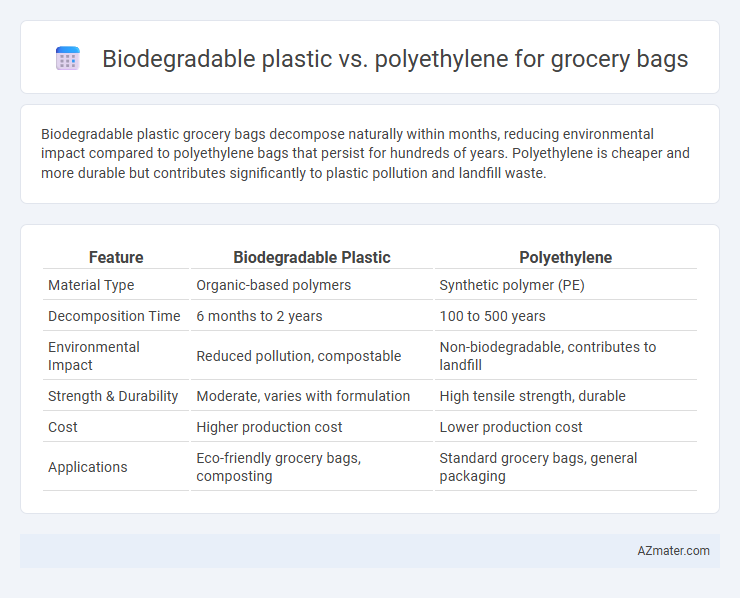Biodegradable plastic grocery bags decompose naturally within months, reducing environmental impact compared to polyethylene bags that persist for hundreds of years. Polyethylene is cheaper and more durable but contributes significantly to plastic pollution and landfill waste.
Table of Comparison
| Feature | Biodegradable Plastic | Polyethylene |
|---|---|---|
| Material Type | Organic-based polymers | Synthetic polymer (PE) |
| Decomposition Time | 6 months to 2 years | 100 to 500 years |
| Environmental Impact | Reduced pollution, compostable | Non-biodegradable, contributes to landfill |
| Strength & Durability | Moderate, varies with formulation | High tensile strength, durable |
| Cost | Higher production cost | Lower production cost |
| Applications | Eco-friendly grocery bags, composting | Standard grocery bags, general packaging |
Introduction to Grocery Bag Materials
Grocery bags are commonly made from polyethylene, a durable and cost-effective plastic known for its moisture resistance and strength. Biodegradable plastics, derived from renewable resources such as cornstarch or sugarcane, offer an eco-friendly alternative designed to break down more rapidly in natural environments. Materials like high-density polyethylene (HDPE) and low-density polyethylene (LDPE) dominate traditional grocery bags, while biodegradable options aim to reduce plastic pollution and landfill waste through enhanced compostability.
What Are Biodegradable Plastics?
Biodegradable plastics are materials designed to decompose naturally through the action of microorganisms, typically breaking down into water, carbon dioxide, and biomass within a specific timeframe under certain environmental conditions. These plastics often derive from renewable biomass sources such as corn starch, vegetable fats, or microbial polymers, making them more environmentally friendly compared to conventional polyethylene. Unlike polyethylene, which is a petroleum-based polymer that persists in the environment for hundreds of years, biodegradable plastics aim to reduce waste accumulation and lower the ecological footprint of grocery bags.
Polyethylene: The Conventional Choice
Polyethylene remains the conventional choice for grocery bags due to its durability, cost-effectiveness, and water resistance, making it ideal for carrying heavy loads. Unlike biodegradable plastics, polyethylene offers superior mechanical strength and moisture barrier properties, which contribute to its widespread adoption in retail. The environmental concerns related to polyethylene stem primarily from its persistence in ecosystems, as it takes hundreds of years to decompose, thereby posing significant waste management challenges.
Environmental Impact Comparison
Biodegradable plastic grocery bags degrade faster in natural environments, reducing long-term pollution and minimizing microplastic accumulation compared to polyethylene bags, which can persist for hundreds of years. The production of biodegradable plastics often uses renewable resources, lowering greenhouse gas emissions, whereas polyethylene derives from fossil fuels, contributing significantly to carbon footprint and resource depletion. However, improper disposal of biodegradable bags in landfill conditions may limit their environmental benefits, while polyethylene bags' resistance to degradation causes extensive soil and marine contamination.
Decomposition Rates and Mechanisms
Biodegradable plastics decompose through microbial activity, breaking down into water, carbon dioxide, and biomass within months to a few years under industrial composting conditions, whereas polyethylene bags can take hundreds of years to degrade due to their strong carbon-carbon bonds. Polyethylene undergoes slow photodegradation and mechanical fragmentation, resulting in microplastics rather than complete mineralization. The faster decomposition rate of biodegradable plastics reduces long-term environmental pollution in grocery bag applications.
Resource Consumption in Production
Biodegradable plastic for grocery bags typically requires fewer non-renewable resources compared to polyethylene, as it is often derived from renewable materials like corn starch or sugarcane. Polyethylene production relies heavily on petroleum, contributing to higher fossil fuel consumption and environmental impact. The resource efficiency of biodegradable plastics can reduce overall greenhouse gas emissions during production, making them a more sustainable choice in terms of resource consumption.
Strength and Durability for Grocery Use
Biodegradable plastic grocery bags offer moderate strength but tend to degrade faster under stress, making them less durable than polyethylene bags for repeated use. Polyethylene bags, especially high-density polyethylene (HDPE), provide superior tensile strength and resistance to tearing, ensuring reliable performance when carrying heavy groceries. The durability advantage of polyethylene supports longer usage, whereas biodegradable options prioritize environmental impact over extended physical resilience.
Cost Analysis: Biodegradable vs Polyethylene Bags
Biodegradable grocery bags generally have higher production costs compared to polyethylene bags due to the use of specialized raw materials and manufacturing processes. Polyethylene bags are cheaper to produce in large volumes, making them more cost-effective for retailers and consumers. Over time, biodegradable bags may offer cost savings in waste management and environmental compliance, balancing upfront expenses with long-term benefits.
Consumer Adoption and Market Trends
Consumer adoption of biodegradable plastic grocery bags is growing due to rising environmental awareness and regulatory incentives, with market trends indicating increased demand for sustainable alternatives to traditional polyethylene bags. Polyethylene remains dominant because of its low cost and durability, but shifting consumer preferences and stricter plastic bans are driving retailers to offer biodegradable options. Market analysis reveals that the biodegradable grocery bag sector is expected to expand at a compound annual growth rate (CAGR) of over 15% through 2030, reflecting a significant shift towards eco-friendly packaging solutions.
Future Outlook: Sustainable Packaging Solutions
Biodegradable plastic offers a promising future for grocery bags by significantly reducing environmental impact through faster decomposition compared to traditional polyethylene, which can persist in ecosystems for centuries. Innovations in biodegradable polymers, such as polylactic acid (PLA) and polyhydroxyalkanoates (PHA), enhance the material's strength and compostability, meeting consumer demand for eco-friendly packaging. Market trends indicate a growing shift toward sustainable packaging solutions, driven by regulatory pressures and increased corporate commitments to reduce plastic waste, positioning biodegradable alternatives as the preferred choice over polyethylene in the coming decades.

Infographic: Biodegradable plastic vs Polyethylene for Grocery bag
 azmater.com
azmater.com